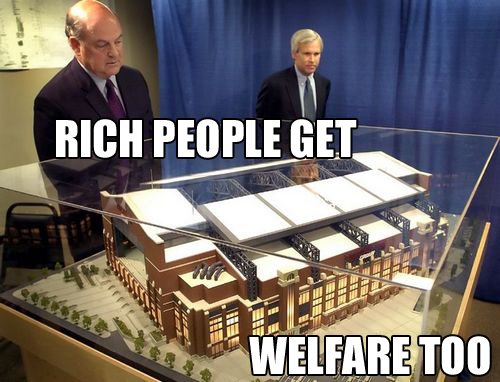Several years ago, Jim Irsay and the leadership of Indiana and Indianapolis sparked a new trend: Publicly funded stadiums. It had been done before, but Irsay has since become a vocal advocate for publicly financed stadiums. Now even the Indiana Pacers are in on the act, despite CIB shortfalls.
ESPN is not usually a source for political commentary, but one column yesterday caught my eye. It’s a round-up of news in the NFL. The point made by author Gregg Easterbrook .
“This Telecast is Copyrighted by the NFL for the Private Profit of Its Owners”:
The NFL said last week it might “contribute” some capital to construction of a new stadium for the Raiders. How generous! Set aside that the league might issue tax-free bonds, so even what appeared on paper to be free-market funding would be subsidized. Funding for the Forty Niners’ new field under construction in Santa Clara appears to be private capital but actually is tax-exempt bonds backed by a California stadium authority.
Typical example: the gleaming new Lucas Oil Stadium, where the Colts perform, was funded by $615 million from Indiana taxpayers and $100 million from the NFL, yet all profits generated in the stadium are converted to the private luxury of the Irsay family, the Colts’ owners.
If Indianapolis or California or other state taxpayers are, through their elected representatives, foolish enough to allow their money to be used to build sports facilities where all profits are converted into private luxury, then taxpayers have only themselves to blame.
But consider that the lion’s share of NFL income is television rights fees. These fees sell for so much because images generated inside publicly funded NFL stadia can be copyrighted — treated as the private property of the NFL and its owners. Why do images created at public expense become private property?
An NFL stadium that is entirely privately funded — there are a few, including Gillette Stadium — should be viewed as a private performance space, analogous to a Broadway theater, where the images created are private property. But a publicly funded stadium should be viewed as a public space, analogous to a park, where images created cannot be owned.
Congress is notoriously lax in oversight of professional sports, many members of the House and Senate being more concerned with free tickets to owners’ boxes than with safeguarding the public interest. Suppose Congress (in some cases state legislatures) enacted legislation stipulating that in any sports stadium built with public funds, game images are public domain. This would mean that CBS could have broadcasted Sunday’s Tennessee at Indianapolis game — but so could History Channel, Telemundo or anyone else. Fans could broadcast the game from their smart phones.
Placing game images from publicly funded stadia into the public domain would be fairness to average people, versus the current system that is rigged to favor the rich. Of course, if NFL games images from stadia with public funding were not the NFL’s private property, rights fees for NFL broadcasts would plummet. So either the NFL and its owners could pay all construction costs themselves, or surrender control of NFL broadcasting. The sole argument in favor of the current system is that wealthy insiders like it.
Bold and Italics are mine. Sadly, the trough is open for permanent feeding in Indianapolis. The mechanism designed by Irsay, Mitch Daniels, Bart Peterson, and other elected officials have be used to build public sports stadiums in Fort Wayne and other Indiana cities.
One cannot deny the benefit of having a sports team and a stadium in our capital city. But I would rather a sports owner become a billionaire on their own dime (like Kraft of the Patriots) instead of on my dime (like Mr. Irsay).

